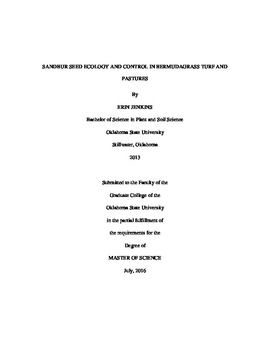| dc.description.abstract | Two experiments were initiated in Perkins, Oklahoma to evaluate and compare control methods of 22 turf herbicide products for southern sandbur (Cenchrus echinatus L.). Bermudagrass [Cynodon dactylon (L.) Pers.] and sandbur were rated by visual percentage injury, coverage, and sandbur control. At 15 weeks after treatment (WAT), all treatments, excluding oryzalin, showed increased sandbur control compared to the non-treated. Oxadiazon controlled 75% of the sandbur and resulted in the best control at 15 WAT. However, PRE products lost their efficacy and sandbur recovered by 18 WAT where no treatment was better than the non-treated. In POST trials, a few herbicides injured bermudagrass and caused delays in healthy growth. At 6 WAT, thiencarbazone-methyl + foramsulfuron + halosulfuron-methyl, amicarbazone, topramezone, and mesotrione caused the highest bermudagrass injury at 20%. Fortunately, by 9 WAT, the bermudagrass began to recover and no treatment thinned the bermudagrass stands. Trifloxysulfuron provided 4 weeks of continuous control at 68%; however, sandbur began to recover by 8 WAT and control decreased to 28%. By 8 WAT, no treatment controlled sandbur more than 40%.Pasture trials were initiated near Hennessey, Oklahoma to evaluate and compare control methods of 10 herbicide products for longspine sandbur [Cenchrus longispinus (Hack.) Fern.]. Bermudagrass and sandbur were rated by visual percentage injury, coverage, and sandbur control. Of all 10 products, imazapic and glyphosate applied POST caused up to 9 weeks of bermudagrass injury with injury peaking at 40 and 55%, respectively. Imazapic and glyphosate also controlled the longspine sandbur most effectively, offering 70 and 98 percent control at 3 WAT and between 75 and 90% control at 9 WAT. Although nicosulfuron + metsulfuron methyl (MSM) and nicosulfuron + MSM + pendimethalin did not control sandbur as efficiently as glyphosate and imazapic, they did cause significant inflorescence suppression without causing unrecoverable bermudagrass injury. Two greenhouse experiments were initiated in Stillwater, Oklahoma to evaluate and compare bur deformities and seed viability. The experiments were factorial in design with factor 1: application timing, and factor 2: herbicide. Results from both studies indicated that early applications made on 1 to 3 week old sandbur plants can cause significant decrease in seed viability and floret production. | |
